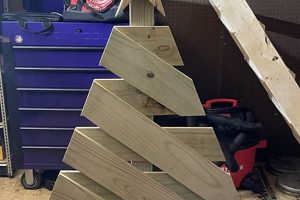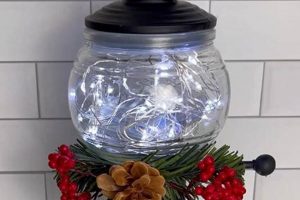The construction of a holiday display from reclaimed wooden platforms has become a popular trend in recent years. This approach involves disassembling and repurposing these ubiquitous shipping structures to create a festive, often rustic, decorative object intended to mimic a traditional evergreen during the Christmas season.
The appeal of utilizing recycled materials for seasonal decor stems from several factors. It offers an environmentally conscious alternative to purchasing commercially manufactured decorations, reduces waste, and often results in unique, personalized creations. Furthermore, the use of such materials can represent a cost-effective solution, particularly for individuals seeking budget-friendly holiday adornments. Historically, the practice of repurposing found objects for decorative purposes aligns with broader trends in sustainable living and resourcefulness.
The subsequent sections will detail the process of creating such a display, covering material selection, construction techniques, and options for personalization. This includes guidance on sourcing suitable materials, safely disassembling the structures, design considerations, and finishing techniques to achieve a desired aesthetic.
Construction and Design Considerations
The following guidelines provide crucial information for successfully building a decorative holiday display using reclaimed wooden platforms. Adherence to these points will contribute to a structurally sound and aesthetically pleasing final product.
Tip 1: Material Selection: Prioritize platforms constructed from heat-treated (HT) lumber over those treated with Methyl Bromide (MB), as the latter is a hazardous fumigant. Examine the wood for signs of rot, insect infestation, or chemical contamination before use.
Tip 2: Safe Disassembly: Employ appropriate safety gear, including gloves and eye protection, during disassembly. Utilize tools designed for nail and staple removal to minimize damage to the wood. Consider the structural integrity of each board before attempting removal.
Tip 3: Design Planning: Develop a detailed plan outlining the dimensions, shape, and overall design of the finished display. Consider the intended location and available space to ensure proper sizing.
Tip 4: Precise Cutting: Accurate measurements and clean cuts are essential for a professional appearance. Utilize a saw with a fine-tooth blade to minimize splintering and ensure smooth edges.
Tip 5: Secure Assembly: Employ appropriate fasteners, such as screws or nails, to securely join the individual boards. Pre-drilling pilot holes can prevent splitting, particularly when working with dry or brittle wood.
Tip 6: Sanding and Finishing: Thoroughly sand all surfaces to remove splinters and create a smooth finish. Apply a sealant or paint to protect the wood from the elements and enhance its aesthetic appeal. Consider using non-toxic finishes, especially if the display will be located indoors.
Tip 7: Illumination Considerations: If incorporating lights, use low-voltage LED lights to minimize the risk of fire and reduce energy consumption. Securely attach the lights to the structure, ensuring that cords are properly managed to prevent tripping hazards.
Following these guidelines ensures a safer and more refined outcome when constructing a holiday display from recycled materials. Careful planning and execution are paramount to achieving a durable and visually appealing creation.
The subsequent section will address various decorative options and personalization techniques to further enhance the aesthetic of the finished holiday display.
1. Sourcing
The acquisition of wooden platforms constitutes the foundational element in the construction of a decorative holiday display utilizing repurposed materials. Responsible and informed procurement directly impacts the structural integrity, aesthetic appeal, and overall safety of the finished product.
- Material Integrity and Safety
Prioritization of heat-treated (HT) platforms over those treated with Methyl Bromide (MB) is paramount due to the latter’s toxicity. Thorough inspection for rot, insect infestation, or chemical contamination is essential to ensure the safety and longevity of the structure. Neglecting this aspect may compromise the structural integrity of the display and pose health risks.
- Ethical Considerations
Obtaining discarded platforms requires due diligence to ensure compliance with local regulations and respect for property rights. Unauthorized removal from commercial premises constitutes theft. Establishing relationships with local businesses to acquire unwanted platforms through legal channels represents an ethical and sustainable sourcing practice.
- Platform Suitability
Not all platforms are created equal; assessing dimensions, wood type, and overall condition is crucial. Selecting platforms with minimal damage and consistent wood grain facilitates easier assembly and a more uniform aesthetic. Variations in wood thickness and species may necessitate adjustments in construction techniques.
- Environmental Impact
Repurposing existing platforms reduces the demand for newly manufactured lumber, thereby minimizing deforestation and associated environmental impacts. Sourcing from local businesses further reduces the carbon footprint associated with transportation. Choosing platforms that are destined for landfill diverts waste and promotes a circular economy.
The selection process represents a crucial determinant in the overall success of constructing a decorative holiday display from reclaimed wooden platforms. Conscious sourcing decisions not only ensure the quality and safety of the finished product but also contribute to environmentally responsible practices.
2. Disassembly
The initial step in repurposing wooden platforms for holiday displays involves deconstruction, a process that dictates the quality and quantity of usable material. The method employed during this phase significantly impacts the structural integrity and aesthetic potential of the finished product.
- Safe Practices and Personal Protection
Disassembly inherently presents risks of injury. Sharp fasteners, splintered wood, and potential instability necessitate the use of protective gear, including gloves and eye protection. Proper tool selection, such as specialized nail pullers and pry bars, minimizes the risk of accidents and damage to the wood. Neglecting safety protocols can lead to injuries and compromise the project’s viability.
- Techniques for Minimizing Material Damage
The objective is to extract individual boards with minimal splintering, cracking, or warping. Gentle leverage, combined with strategic tool placement, reduces stress on the wood fibers. Forcing fasteners can result in irreparable damage, rendering the material unusable. Careful and deliberate techniques preserve the maximum amount of usable material, maximizing resource efficiency.
- Fastener Removal Methods
Nails, screws, and staples represent common fastening methods. Each requires a specific removal technique. Nail pullers offer leverage for extracting nails without excessive force. Screwdrivers remove screws cleanly, while staple removers address the often-embedded staples. Inappropriate tool usage can deform the wood and complicate subsequent assembly.
- Sorting and Categorization of Materials
As boards are detached, sorting by size, species, and condition streamlines the construction process. Categorizing facilitates efficient selection and reduces wasted time searching for suitable pieces. Segregating damaged or unusable boards prevents their accidental incorporation into the final structure.
The meticulous approach to deconstruction lays the groundwork for a successful and aesthetically pleasing holiday display. Skilled disassembly maximizes the yield of usable materials, minimizes waste, and enhances the overall quality of the final product. This stage is not merely destructive; it is a crucial preparatory step in transforming discarded materials into a unique and festive decoration.
3. Design
The design phase is a critical determinant in the successful creation of a decorative holiday display from reclaimed wooden platforms. It establishes the aesthetic direction, structural integrity, and overall feasibility of the project. A well-considered design mitigates potential challenges arising from the inherent variability of reclaimed materials and ensures the finished product aligns with the intended purpose and environment. Without a defined plan, the project risks becoming an unstructured assemblage of materials, lacking visual cohesion and structural soundness. For instance, a design might incorporate specific lighting configurations, requiring internal bracing and wire management considerations to be addressed during the construction phase. This forethought prevents the ad-hoc addition of features that can compromise structural integrity or aesthetic appeal.
Practical design considerations encompass several key areas. First, dimensional planning is essential to determine the overall size and shape of the finished display, ensuring it is appropriately scaled for its intended location. Second, material allocation, guided by the design, dictates the optimal utilization of reclaimed boards, minimizing waste and maximizing resource efficiency. Third, structural support mechanisms must be integrated into the design to ensure stability, particularly for larger or more complex structures. A real-world example involves designing a tiered display with shelves for ornaments; the design must specify the dimensions and placement of support beams to prevent sagging or collapse. Effective design thereby transforms the abstract idea of a repurposed holiday decoration into a tangible, actionable plan.
In summary, the design phase provides the blueprint for realizing a cohesive and structurally sound holiday display from reclaimed materials. Careful planning addresses practical challenges, optimizes material utilization, and ensures the finished product aligns with aesthetic goals and environmental considerations. A deliberate and informed design process is indispensable for transforming a collection of discarded wooden platforms into a visually appealing and enduring holiday decoration.
4. Cutting
The process of cutting repurposed wooden platforms is intrinsically linked to the creation of decorative holiday displays. Accurate and deliberate cutting is essential for achieving the desired aesthetic and structural integrity of the finished object. Cutting is not merely a subtractive process but a foundational step in transforming raw material into a cohesive and visually appealing form.
- Precision and Accuracy
Accurate measurements and clean cuts are essential for creating well-defined shapes and ensuring proper alignment of components. Imprecise cuts can lead to gaps, uneven surfaces, and a compromised overall appearance. For example, in creating the conical shape of a tree, even slight inaccuracies in the angles of individual boards will accumulate, resulting in a distorted or asymmetrical form. Precise cutting, therefore, directly contributes to the visual quality of the final piece.
- Material Optimization and Waste Reduction
Strategic cutting patterns can maximize the utilization of available material and minimize waste. Careful planning and layout techniques ensure that boards are used efficiently, reducing the amount of unusable scraps. Consider nesting smaller pieces within larger cutouts to minimize waste. This not only reduces material costs but also promotes environmentally responsible construction practices.
- Tool Selection and Safety
The choice of cutting tools significantly impacts the quality and safety of the process. A saw with a fine-tooth blade minimizes splintering and produces clean, smooth edges. Appropriate safety gear, including eye protection and hearing protection, is essential to prevent injuries. Utilizing the correct tool for the task ensures precision and minimizes the risk of accidents.
- Creating Specific Design Elements
Cutting enables the creation of specific design elements that define the overall aesthetic of the finished display. Boards can be cut into various shapes and sizes to create texture, patterns, and visual interest. Angled cuts can be used to create a tiered or layered effect, while decorative cutouts can add intricate details. Cutting is, therefore, a versatile technique that allows for a high degree of personalization and creative expression.
These facets of cutting, taken together, underscore its critical role in the construction of repurposed holiday displays. The process demands careful planning, precise execution, and a commitment to safety and efficiency. Skillful cutting is the linchpin in transforming reclaimed wooden platforms into visually appealing and structurally sound holiday decorations.
5. Assembly
The assembly phase represents the culmination of preceding efforts in the creation of a decorative holiday display from repurposed wooden platforms. It is the stage where individual components, carefully sourced, disassembled, cut, and prepared, are united to form a cohesive and structurally sound entity. The effectiveness of the assembly process directly determines the stability, durability, and overall aesthetic appeal of the finished product. Inadequate assembly techniques can compromise the integrity of the entire structure, rendering the previous stages of preparation futile. For instance, the use of insufficient fasteners or improper joint construction can lead to instability, particularly in larger or more complex designs. Assembly, therefore, functions as a critical nexus point in realizing the design vision.
Practical assembly considerations encompass several key areas. Primarily, the selection and application of appropriate fastening methods are paramount. Screws, nails, adhesives, or a combination thereof, must be chosen based on the type of wood, the load-bearing requirements of the joint, and the desired aesthetic. Pre-drilling pilot holes minimizes splitting, especially when working with older or brittle wood. Secondly, alignment and precision are crucial for maintaining the intended design geometry. Clamps and jigs can assist in holding components in place during the fastening process, ensuring accurate alignment and preventing warping or distortion. Thirdly, structural reinforcement may be necessary to enhance stability, particularly for larger displays. Braces, gussets, or internal supports can be integrated into the design and added during assembly to provide additional strength and prevent structural failure. Imagine a tiered display; without proper bracing during assembly, the upper tiers could easily collapse under their own weight or the weight of decorations.
In summary, the assembly phase is the pivotal process that transforms individual components into a unified and functional holiday decoration. The choice of fastening methods, the precision of alignment, and the integration of structural reinforcement mechanisms are critical determinants of the overall quality and longevity of the finished display. A well-executed assembly process ensures that the finished product is not only visually appealing but also structurally sound, capable of withstanding the rigors of seasonal use and display.
6. Finishing
The “finishing” stage in the construction of a “diy pallet xmas tree” is integral to its longevity, aesthetic appeal, and safety. It represents the final set of processes applied to the wooden structure after assembly, primarily involving surface treatments to protect the wood, enhance its appearance, and mitigate potential hazards. The selection and application of appropriate finishes directly impact the display’s resilience to environmental factors and its visual integration within a given setting. For example, without a protective sealant, the wood may be susceptible to moisture damage, leading to rot, warping, and ultimately, structural failure. This underscores “finishing” not merely as an aesthetic consideration but as a functional imperative.
Practical applications of “finishing” techniques include sanding to create a smooth surface, thereby removing splinters and preparing the wood for subsequent treatments. Priming, often employed to enhance paint adhesion and provide a uniform base color, represents another crucial step. The choice of paint or stain determines the overall aesthetic and can be selected to complement existing decor or create a specific visual theme. For example, a rustic aesthetic might favor stains that accentuate the wood grain, while a more modern aesthetic could utilize bright, opaque paints. The application of a topcoat, such as varnish or polyurethane, provides a durable, protective layer that resists scratches, moisture, and UV damage, extending the lifespan of the display. Specific challenges include selecting finishes appropriate for outdoor use if the “diy pallet xmas tree” is intended for external display and ensuring proper ventilation during application to minimize exposure to potentially harmful fumes.
In summary, “finishing” transcends mere aesthetic enhancement, functioning as a crucial protective and preservative measure for a “diy pallet xmas tree”. The appropriate selection and application of “finishing” techniques directly influence the display’s durability, safety, and visual impact. Overlooking this stage compromises the long-term integrity and aesthetic value of the constructed item, thereby undermining the resourcefulness and creative effort invested in its creation. This understanding reinforces the interconnectedness of each construction phase and emphasizes the importance of holistic planning in crafting a sustainable and visually appealing holiday decoration.
7. Lighting
Illumination serves as a critical enhancement, transforming a “diy pallet xmas tree” from a rustic structure into a captivating focal point. The integration of lighting not only accentuates the texture and form of the reclaimed wood but also introduces a festive ambiance, essential for holiday decor. Without appropriate lighting, the “diy pallet xmas tree” may appear visually unremarkable, failing to capture the celebratory spirit typically associated with Christmas decorations. For instance, a dimly lit tree might lack the contrast needed to highlight its unique construction, effectively diminishing its visual impact. The selection and placement of lights, therefore, directly influence the overall aesthetic and perceived value of the display.
Practical applications of lighting range from simple string lights to more complex, programmed LED systems. String lights, readily available and easy to install, offer a classic and versatile option. They can be draped across the structure to create a twinkling effect or strategically placed to emphasize specific design elements. LED systems, while requiring more technical expertise, provide greater control over color, brightness, and animation, allowing for customized displays. Consider a “diy pallet xmas tree” designed with internal cavities for housing lights; this design choice enables the creation of intricate lighting patterns that would be impossible with surface-mounted lights alone. Furthermore, the use of solar-powered lights can enhance the environmental friendliness of the display, aligning with the sustainable ethos often associated with DIY projects. Safety considerations are paramount; using low-voltage lights and ensuring proper wire management prevents electrical hazards.
In conclusion, lighting elevates the “diy pallet xmas tree” from a mere construction of reclaimed materials to a visually engaging and festive decoration. The careful selection, placement, and control of illumination are integral to achieving the desired aesthetic and enhancing the overall impact of the display. Understanding the interplay between lighting and the “diy pallet xmas tree” structure allows for the creation of unique, personalized holiday decorations that resonate with both visual appeal and environmental consciousness. Neglecting this aspect diminishes the potential of the project, underscoring the necessity for a comprehensive approach to design and construction.
Frequently Asked Questions
The following addresses common inquiries regarding the construction and deployment of decorative holiday displays from repurposed wooden platforms. Clarification of these points is intended to enhance project success and safety.
Question 1: What are the primary safety considerations when working with reclaimed platforms?
Reclaimed platforms may harbor hidden hazards, including protruding nails, splinters, and potential chemical contamination. The use of appropriate protective gear, such as gloves and eye protection, is mandatory. Thorough inspection for signs of rot or infestation is essential prior to handling the material.
Question 2: How does one determine if a platform is safe for repurposing?
Platforms marked with the “HT” stamp indicate heat treatment, generally considered safe. Platforms bearing the “MB” stamp indicate treatment with Methyl Bromide, a hazardous fumigant, and should be avoided. Visual inspection for discoloration, unusual odors, or signs of insect activity is also recommended.
Question 3: What are the essential tools required for platform disassembly?
A claw hammer, pry bar, reciprocating saw, and safety glasses are considered essential. Specialized nail pullers can facilitate fastener removal with minimal damage to the wood. The selection of tools should align with the specific fasteners encountered during disassembly.
Question 4: How can the structural integrity of the resulting holiday display be ensured?
Proper joint construction, utilizing screws or bolts rather than solely relying on nails, is crucial. Internal bracing can enhance stability, particularly for larger or more complex designs. The weight distribution of decorative elements should be considered to prevent overloading specific sections of the structure.
Question 5: What types of finishes are appropriate for outdoor displays?
Exterior-grade paints, stains, and sealants formulated to withstand moisture, UV radiation, and temperature fluctuations are recommended. Thorough application, following manufacturer instructions, is essential for optimal protection. Regular inspection and maintenance may be required to prolong the finish’s effectiveness.
Question 6: How can lighting be safely integrated into the design?
The use of low-voltage LED lights is advisable to minimize the risk of fire and electrical shock. Secure attachment of light strands and careful management of electrical cords are critical to prevent hazards. Outdoor lighting should be rated for wet locations and connected to a ground fault circuit interrupter (GFCI) outlet.
Adherence to these guidelines contributes to a safer and more successful project outcome. Diligence in material selection, construction techniques, and finishing procedures is paramount.
The following section will address potential design variations and advanced construction techniques.
Concluding Remarks
The preceding analysis has detailed the multifaceted process of constructing a “diy pallet xmas tree,” encompassing material sourcing, disassembly, design considerations, precise cutting techniques, secure assembly methods, appropriate finishing applications, and safe lighting integration. Each stage demands careful attention to ensure structural integrity, aesthetic appeal, and, most importantly, safety throughout the construction and subsequent display phases. The responsible execution of these elements transforms discarded materials into a personalized and environmentally conscious holiday decoration.
The decision to undertake such a project necessitates a commitment to resourcefulness and a willingness to engage in hands-on craftsmanship. As communities increasingly prioritize sustainability and personalized expressions of holiday traditions, the skills and knowledge outlined herein provide a foundation for creating unique and meaningful decorative objects. Further exploration of advanced construction techniques and innovative design adaptations will continue to refine and elevate the practice of constructing “diy pallet xmas tree” displays, reflecting a growing interest in sustainable and personalized holiday ornamentation.







